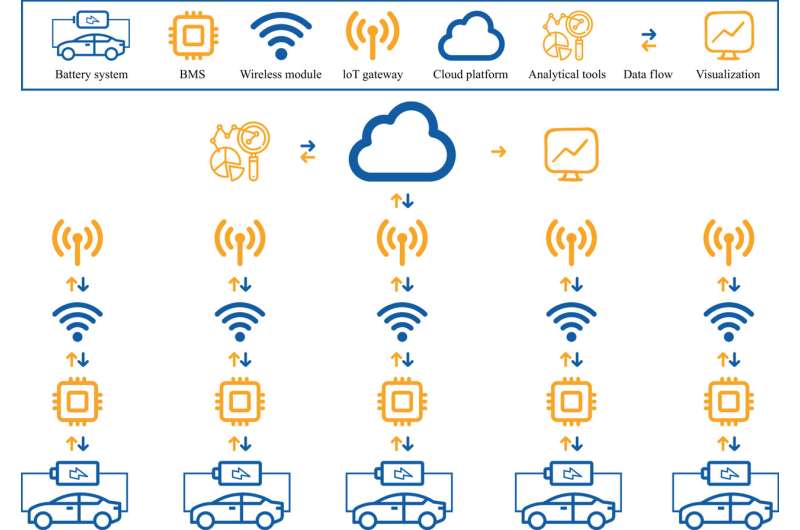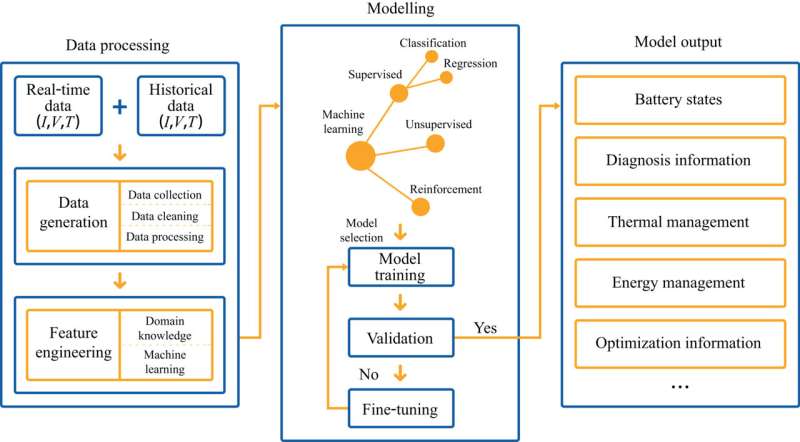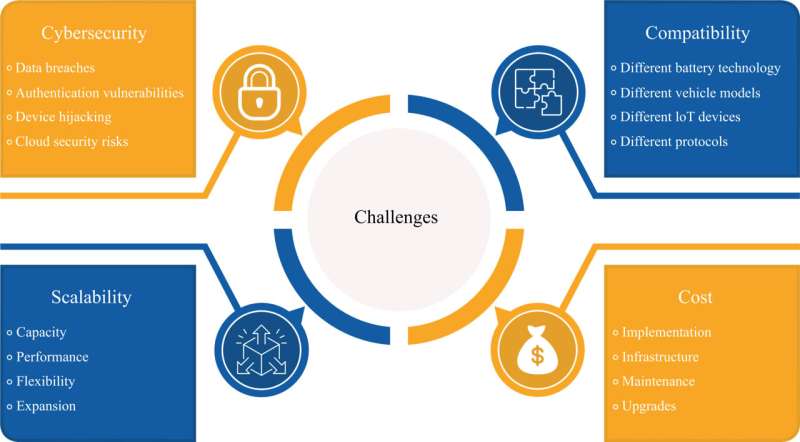This article has been reviewed according to Science X's editorial process and policies. Editors have highlighted the following attributes while ensuring the content's credibility:
fact-checked
proofread
Architectures, opportunities and challenges of internet-of-batteries for electric vehicles

A paper describing the architectures, opportunities, and challenges of the internet-for-batteries (IoB) was published in the journal Green Energy and Intelligent Transportation.
The present battery technology employed in electric vehicles (EVs) faces several critical challenges. Firstly, the limited operation range of EVs remains a major concern for potential users, as it affects their ability to travel long distances without the need for frequent recharging.
Additionally, long charging times are inconvenient for users and can hinder the widespread adoption of EVs. Alongside these limitations, the possibility of battery faults, such as thermal runaway, can lead to safety risks, including fires or explosions. These factors could discourage potential users from adopting EVs, including technical concerns about battery health and safety, the need for frequent recharging, and long charging times.
Furthermore, EV batteries experience degradation over time, decreasing performance and reducing battery lifespan. It leads to an increase in maintenance and accident risk for EV owners.
As a promising solution to these issues, the IoB is a networked system that utilizes the Internet-of-Things (IoT) principles to gather data from EV batteries. This data is subsequently transmitted to a cloud server, where it is utilized for battery state estimation, predictive analytics, and fault diagnosis. In contrast to traditional battery management systems (BMS), IoB leverages advanced technologies like IoT, cloud computing, and machine learning to provide intelligent battery management.

The IoB can be defined as an integrated system that uses the IoT and cloud computing technology to monitor and manage batteries. IoB systems can collect data from batteries in real-time, such as voltage, current, temperature, and other parameters. This data can be used to analyze battery health and performance, identify potential faults, and optimize battery usage. IoB systems can also be used to control batteries remotely. This can help to improve battery efficiency and extend battery life.
The IoB comprises three main components: battery systems, IoT gateway, and cloud platform, and two additional components, i.e., BMS and wireless module, which are integrated inside the battery systems.
Firstly, battery systems form the foundational layer of the IoB architecture, particularly within the context of EVs. Secondly, the wireless module is a critical component of the IoB system for EVs. Thirdly, the IoT gateway bridges the wireless module and the cloud platform, ensuring safe and efficient data transmission. Finally, the cloud platform provides a centralized hub for storing, processing, and analyzing battery data collected from various EVs.
Machine learning is a powerful tool that can be used to improve the efficiency and effectiveness of IoB systems. By analyzing data and learning from patterns, machine learning can help IoB systems make more informed decisions about battery management, charging, usage, and vehicle management.
This can lead to improved battery performance, increased range, and reduced costs for EV owners. Machine learning approaches can be broadly classified into three main categories: supervised, unsupervised, and reinforcement.

The IoB presents numerous promising opportunities, particularly for the EV industry. This digital technology promises benefits such as ongoing battery health checks, improved energy management, state estimation, prediction, and fault diagnosis, significantly transforming the landscape of EV technology.
However, implementing the IoB in EVs presents a number of challenges. The innovative integration of IoT technologies within the BMS of EVs presents a wide range of challenging issues that must be thoroughly addressed for the technology to achieve a reliable state and widespread use.
One of the most prominent concerns in the IoB domain is the security of battery data. Another significant challenge lies in the compatibility between different systems. Lastly, the large-scale application of IoB in EVs comes with its own set of technical complexities.
In the future, more research and development will be needed to fully realize the potential of the IoB and optimize battery use in EVs. Future efforts should address challenges like data security and system compatibility.
Additionally, research should explore the potential role of artificial intelligence and machine learning in enhancing the efficiency and effectiveness of IoB systems. The IoB has the potential to transform the EV industry, but realizing this potential will depend on addressing these challenges and seizing the opportunities it offers.
More information: Heng Li et al, IoB: Internet-of-batteries for electric Vehicles–Architectures, opportunities, and challenges, Green Energy and Intelligent Transportation (2023). DOI: 10.1016/j.geits.2023.100128

















